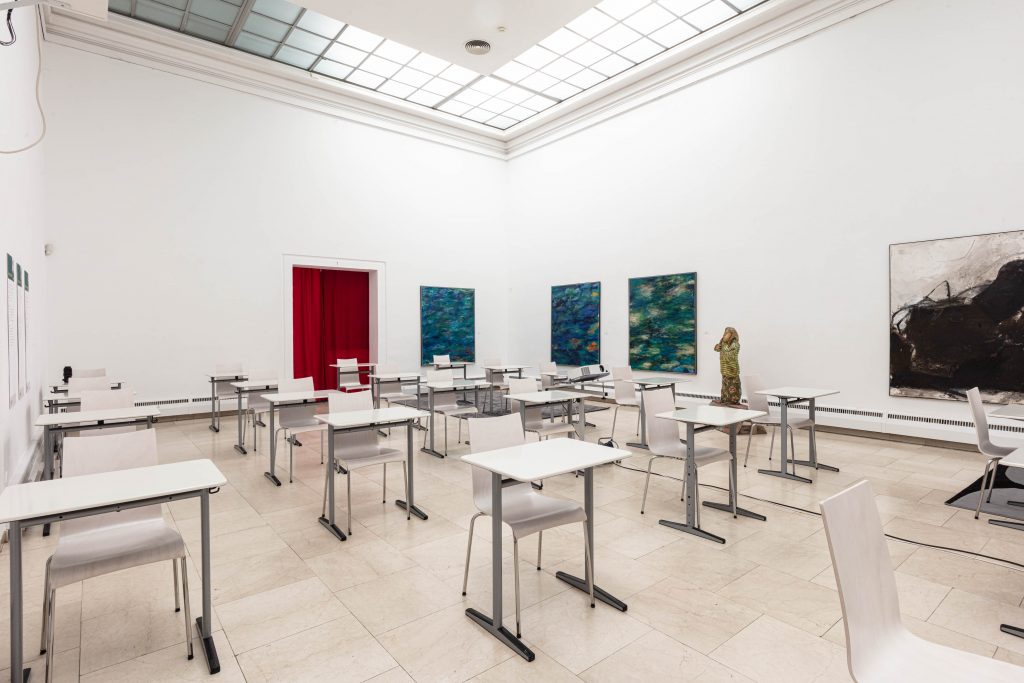Art World
As Germany Extends Its Lockdown, Shuttered Museums Are Offering Up Their Galleries to Cramped and Poorly Ventilated Schools
The country has just extended its lockdown on cultural venues until at least December 20.

The country has just extended its lockdown on cultural venues until at least December 20.

Last month, Monika Hauser-Mair, the director of a small state museum in the German town of Rosenheim, received an unlikely call.
A local school principal was on the line asking if she might consider hosting a senior high school class in the museum, which was closed to the public because of a local lockdown.
The answer? An immediate yes.
Two days later, a blackboard and a projector were rolled in, and tables and chairs were assembled in rows as the Sebastian-Finsterwalder-Gymnasium’s grade 12 class relocated into a brightly lit space adorned with paintings by Fried Stammberger and Peter Tomschiczek, and a sculpture by Erika Maria Lankes.
It made for a nice—albeit unusual—setting for courses in math, German, and social studies.
“The students enjoy the new ambience,” Hauser-Mair tells Artnet News. “We think arts education [should] never stop.”
Schools across the country, struggling to manage with the difficulties of social distancing, poor ventilation, and infections, have been hard hit by the pandemic. Schedules are thrown out when a single coronavirus case shuts down an entire building, and the psychological effects of all this on the students are still largely unknown.
Museums may help ease some of the burden. Often spacious and well-ventilated, they are being floated as possible overflow sites for stuffed (and stuffy) classrooms.The country has just extended its lockdown on cultural venues until at least December 20—so they are eerily quiet.
In an open letter this week to the German chancellor, cultural organizations, including the German museums association and the German theater association, extended a helping hand to schools in need.
“We would like to make an active contribution to the educational opportunities of children and young people in pandemic times,” the organizations wrote, telling the government to “make use” of their resources and experiences, as well as their advanced hygiene protocols. In some states, like the North Rhine Westphalia, class field trips to museums are still allowed under lockdown rules.
While they are unanimous in their desire to support students, not all institutions can agree on what that help should like look. Julia Hagenberg, head of education from the Düsseldorf State Collection, which is holding shows by Hito Steyerl and Simon Denny, points out that most museums are ill-suited for classes. “Exhibition rooms are too coldly air-conditioned for a permanent stay,” she says, adding that museums should not become discipline- and achievement-oriented spaces. “Using them as classrooms would obstruct the possibility of perceiving them as such alternative places.”
But Germany’s federal minister for education, Anja Karliczek, likes the idea. And in an interview this week with Berliner Morgenpost Klaus Lederer, Berlin’s culture minister, also suggested that children should be given priority access to cultural venues. Given the infrastructures in place at museums, such as staff educated in public outreach, there are many potential routes.
The plan could make sense given that the current lockdown will be extended for German cultural institutions until at least December 20, and possibly into January should infections continue to rise. Museums and other cultural venues have been closed since November 1.
“Special times challenge us to develop special ideas,” says Christina Végh, director of the Bielefeld Kunsthalle, who has been meeting with officials from the education sector to workshop ideas. “Existing infrastructures could be used, and new formats could be developed according to the needs of the educational institutions.” Museums, she says, can offer “other ways of teaching.”
But there are still some roadblocks the government needs to lift. “The current legal situation continues to restrict cultural institutions, meaning that we have no room to maneuver to make possible offers to education [institutions],” she says. Were that to change, “it would send a signal that education and culture are recognized for their high social value.”
Whatever happens, the moment does provide a useful lesson: that museums were educational facilities all along.